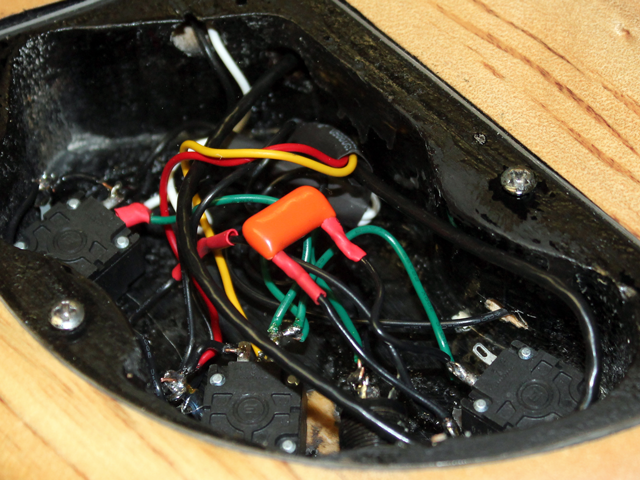By Michael DuFault, Web Content Graphic Designer, Mouser Electronics
 I recently revamped an old bass guitar after growing tired of waiting to upgrade to a new guitar. Being thrifty, I decided first to see what life I could breathe back into this cheap instrument before committing to a newer, more expensive guitar. This included completely stripping the paint, sanding out all dents and dings, refinishing with tung oil, and most importantly, totally overhauling the pickups and electronics.
I recently revamped an old bass guitar after growing tired of waiting to upgrade to a new guitar. Being thrifty, I decided first to see what life I could breathe back into this cheap instrument before committing to a newer, more expensive guitar. This included completely stripping the paint, sanding out all dents and dings, refinishing with tung oil, and most importantly, totally overhauling the pickups and electronics.
As a member of the Mouser marketing team, I recently had the opportunity to help create an audio applications site, which included a section for guitar/bass wiring. During the process of creating the site, ideas started floating around in my head about what I could do to the abused old bass I had sitting at home. Once the site was nearly finished, I made the jump and ordered a pack of Bourns Model 95 potentiometers , some Cornell Dubilier Orange Drop capacitors , a Neutrik input jack , some hookup wire and some after-market bass pickups.
Using the wiring diagram on our site as a starting point, I gutted and removed the existing electronics and got to work. My bass would still be using passive pickups in a PJ configuration, volume knobs for each pickup, and a tone control knob. I installed my new pickups along with the Bourns potentiometers.
 These Model 95 potentiometers have a sealed plastic housing instead of a more traditional metal housing. The pots use a sealed conductive polymer conductor rather than the typical carbon resistive element. This means they are not affected by humidity and temperature in the same way other pots are, giving the player a more consistent performance and the parts a longer life. Products in this series are also available with an audio taper, which allows a smoother transition from minimum to maximum volume and tone.
These Model 95 potentiometers have a sealed plastic housing instead of a more traditional metal housing. The pots use a sealed conductive polymer conductor rather than the typical carbon resistive element. This means they are not affected by humidity and temperature in the same way other pots are, giving the player a more consistent performance and the parts a longer life. Products in this series are also available with an audio taper, which allows a smoother transition from minimum to maximum volume and tone.
Traditionally, pots with a metal enclosure would have you ground your wiring to the back of the enclosure, but since the Model 95 uses a plastic enclosure they provide a more preferable option. Each part includes a special solder lug washer that attaches to the shaft and offers a lead to solder a jumper wire to. Using the provided washer when installing these proved to be very easy and ended up making for a far neater soldering job when all was said and done. I found that the pots themselves feel great to the touch and have a nice and extremely even taper.
Next I attached the Cornell Dubilier Orange Drop capacitor to the tone knob. After quickly soldering and heat shrinking the leads to my solder lug and pin, I was done. The Orange Drop I used was a 100V (the lowest available and more than ample for this application) at a value of 4700 pF. My tone knob was transformed! Previously, rolling down the tone created a quickly unusable muffled mess. With the combination of the Bourns and Cornell Dubilier parts, I now had a smooth taper from a full-bodied sound to a smooth and creamy, totally usable sound at the opposite end.
The last task was to replace the old input jack with a Neutrik connector. This is a pretty straightforward change but is an improvement in terms of durability. I simply fed the new long-threaded connector through the existing hole in the body and wired it up appropriately.
The cosmetic changes to the bass were by far the most difficult to do, so afterwards the wiring changes were a joy. Once I put everything back together and gave the guitar a setup, this bass played like a dream. I would now put this instrument up against basses that cost two or three times as much in a shop and no longer feel the need to trade up, not to mention that I was able to give it a personal flair that suits my playing style!
Related Mouser Links :
My Parts List :
Bourns Model 95 – 652-95A1DZ28EA0303L
Cornell Dubilier Orange Drop – 598-225P47291WD3
Neutrik Input Jack – 568-NYS220
Michael DuFault is a Web Content Graphic Designer for Mouser Electronics, Inc. and a lifelong musician. He plays guitar and keyboard in Automorrow and makes chiptune music on old video game consoles as MicroD.
Advertisement
Learn more about Mouser Electronics





